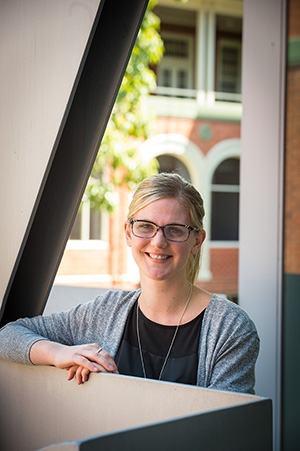Data unites high achievers
Research news
Before she was a world class cyclist and dual Olympian, Tracey Gaudry, UCI Vice President and President of the Oceania Cycling Confederation, was a Deakin student and statistician working on the first stages of what has become Geelong’s longest running and largest population-based study, the Geelong Osteoporosis Study (GOS).
More than 20 years later, Tracey was back at Deakin delivering the occasional address at the April graduation of PhD student Dr Shae Quirk, who based her thesis on data collected since the mid-1990s by the very same study.
“When we started GOS, Tracey devised the statistical method for us to select our random cohort from electoral rolls for the region,” said GOS Chief Investigator Prof Julie Pasco.
Prof Pasco heads up the Epi-Centre for Healthy Ageing at Deakin University’s Research Centre for Innovation in Mental, Physical and Clinical Treatment (IMPACT).
The study initially recruited a cohort of 1500 women from the ABS Barwon Statistical Division and recruitment of a male cohort of the same size began in 2001.
“I think it’s really special that someone who was involved in starting the study all those years ago played such an important role in the graduation of a student who used data from the study to complete her PhD,” Prof Pasco said.
Originally designed to investigate the pattern of osteoporosis in the population and its associated risk factors, the GOS has collected such a volume of data over the years and such large sample cohorts that researchers are able to use the information to investigate broader topics, such as the patterns of obesity and diabetes in the Geelong region and risk factors for chronic diseases and disorders associated with ageing.
Over time, the study has achieved a number of “firsts,” breaking the news in 2011 that the prevalence of osteoporosis and osteopenia, a potential precursor to osteoporosis, in Australians was far higher than previously thought.
GOS researchers also: developed the reference ranges for bone density scans used clinically to identify people at risk of fracture; were one of the first groups to show that fracture rates change with seasonal variations in vitamin D levels; and were the first to report a link between high inflammation and a higher risk of both fracture and depression.
A psychiatric interview was introduced as part of the study some years ago, allowing researchers to look for links between physical and mental health.
Dr Quirk has since reported on the prevalence of personality disorders in the female study population and their association with physical and mental health disorders and health service utilisation in her thesis, “Personality Disorders in the Community.”
She will now investigate the same issues in the male study population.
“GOS is a huge platform for many interconnected research topics,” Prof Pasco explained, citing the study’s findings that the problem of morbid obesity in women in the region is growing, that hip fracture rates are decreasing and a current PhD student’s investigation of the levels of health literacy in the cohort.
“In her address, Tracey told graduates that they have an endless capacity to make a difference,” Prof Pasco said.
“I think that also applies to the study she helped get off the ground all those years ago.
“Working on a study of this size for such a length of time is a wonderful opportunity to see how patterns of disease change through the years. We are delighted to work with different collaborators and see how the involvement of different students can broaden the utility of our data.”
Share this story
 Dr Shae Quirk.
Dr Shae Quirk.
